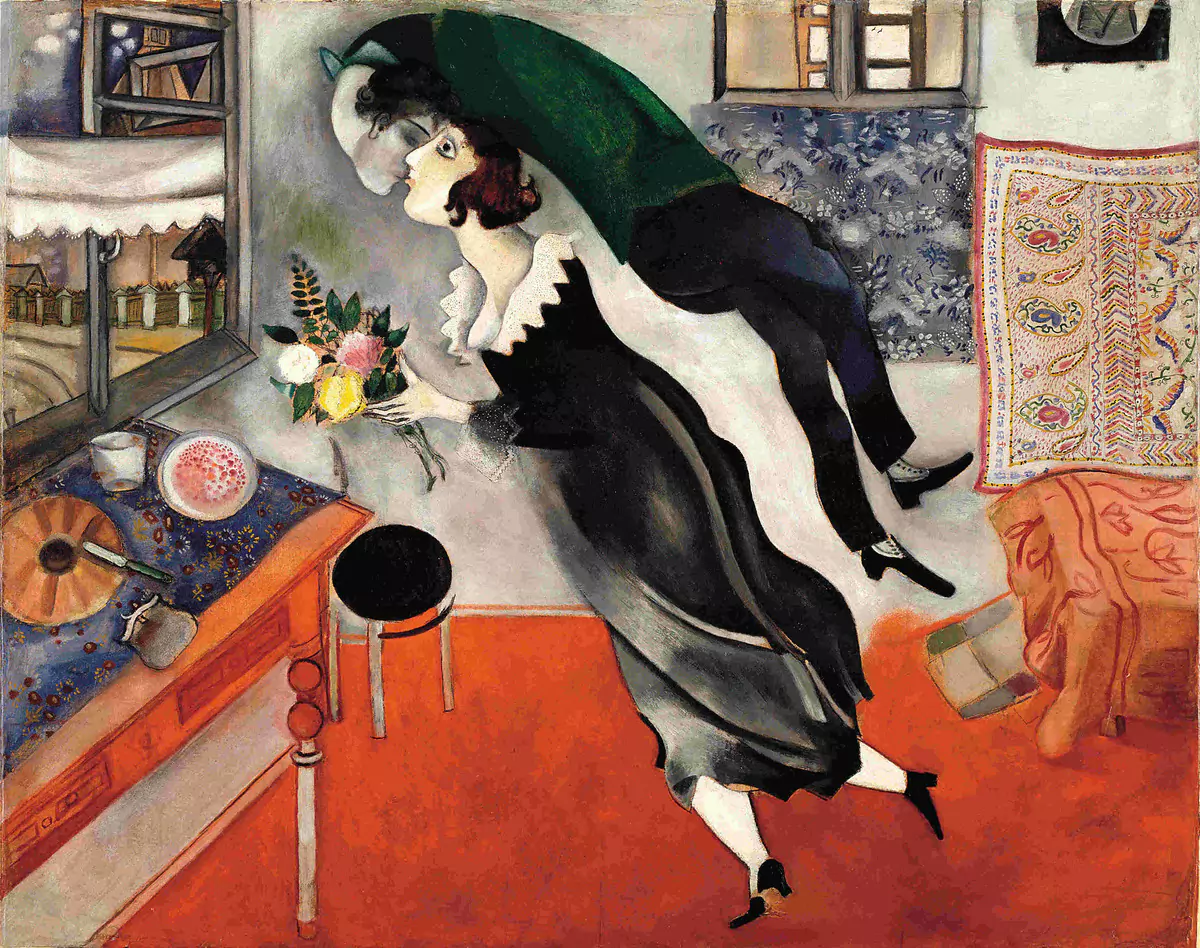Looking for a muse? Check no further. Discover the Best of Art, Culture, History & Beyond!

Marc Chagall, Birthday , Oil on Cardboard , 1915, MOMA, Museum of Modern Art in New York.
Technical Details
Title: Birthday
Artist: Marc Chagall
Date: 1915 Medium: Oil on cardboard
Dimensions: 31 3/4 × 39 1/4 in. (80.6 × 99.7 cm)
Current Location: The Museum of Modern Art (MoMA), New York
Love, Art, and the Magic of a Moment
Few artists capture the sheer intoxication of love quite like Marc Chagall. His 1915 painting Birthday, now housed in The Museum of Modern Art (MoMA), New York, is a poetic tribute to love—not just any love, but that dizzying, all-consuming kind that makes you feel like you’re floating. And in Chagall’s case, he quite literally is.
If you’ve ever been in love, you know that head-spinning, gravity-defying sensation where reality bends and the world feels charged with a special kind of electricity. That’s exactly what Birthday captures: a surreal, dreamlike vision of Chagall and his beloved Bella Rosenfeld, locked in a moment of weightless ecstasy. It’s romantic, whimsical, and just a little bit magical.
But this is more than just a sentimental love story—it’s an artwork rich with symbolism, personal history, and artistic innovation. Let’s step inside Chagall’s world and see what makes Birthday so extraordinary.
A Love Story Painted in Mid-Air
Chagall painted Birthday in 1915, the same year he married Bella Rosenfeld, the love of his life. They had met a few years earlier in Vitebsk, Russia, and their connection was instant. In her memoir, Bella wrote:
“When Marc took my hand, I felt as if we had been together forever.”
That deep emotional bond radiates through Birthday. The scene is deceptively simple: a cozy interior, a bouquet of flowers, a richly patterned carpet, and two lovers caught in a moment of joyful surprise. But look closer—Chagall is floating.
His body bends and twists in a gravity-defying embrace, his head nearly upside-down as he stretches toward Bella for a kiss. She remains grounded, one hand holding flowers, but her face tilts up to meet him in an impossibly delicate moment. It’s as if love has lifted him off his feet—quite literally.
Dreams, Flight, and Chagall’s Unique Vision
Floating figures are a signature of Chagall’s work. In his paintings, people drift above rooftops, animals take on mystical forms, and reality melts into dreamlike compositions. His art exists in a space between memory, fantasy, and the everyday.
For Chagall, flight wasn’t just a metaphor—it was an emotional truth. Love, creativity, and nostalgia had the power to lift you off the ground, to transport you beyond the ordinary world. His influences came from multiple sources:
- Jewish folklore and mysticism – Stories of floating prophets, dream visions, and miraculous occurrences often appeared in his childhood tales.
- Russian icon painting – Chagall’s figures sometimes echo the floating saints in Orthodox religious imagery.
- Surrealism (before Surrealism even existed!) – Long before artists like Salvador Dalí and René Magritte started painting impossible realities, Chagall was already breaking the rules of physics on canvas.
This ethereal quality makes his paintings feel deeply personal yet universally relatable. Who hasn’t felt like they were flying when overwhelmed by happiness?
Color and Emotion: A Celebration of Life
Color is the emotional heartbeat of Chagall’s work. In Birthday, he uses deep reds, soft pinks, and golden yellows, creating an atmosphere that feels warm and intimate. The bold patterns on the rug and furniture add a sense of energy, movement, and a connection to his Russian-Jewish roots.
Each color plays a role:
- Red dominates the scene, symbolizing passion, warmth, and vitality.
- Black and dark tones in the furniture ground the composition, providing contrast.
- Soft pastels on Bella’s dress and the flowers give a sense of tenderness and lightness.
Despite its simple domestic setting, the painting radiates with movement and joy, as if every object and brushstroke is infused with the couple’s love.
A Moment of Happiness Before the Storm
While Birthday captures a blissful moment, it was created on the edge of a turning point in Chagall’s life. The year 1915 wasn’t just the year of his marriage—it was also the beginning of World War I, a conflict that would reshape the world and his own fate.
Soon after, Chagall and Bella’s idyllic life in Russia was disrupted by war, revolution, and exile. They would eventually leave their homeland, moving to Paris, then New York, and later back to France. Their love endured, but their world changed dramatically.
This makes Birthday even more poignant—it’s a snapshot of a fleeting moment, a perfect happiness caught before everything shifts.
Why Birthday Still Feels Fresh Today
More than a century later, Birthday still resonates. It’s not just a historical artifact—it’s a timeless expression of love, spontaneity, and the power of imagination.
Chagall’s work reminds us that:
- Love can lift us up – Emotion isn’t bound by logic; sometimes, it makes us weightless.
- Art doesn’t have to follow the rules – Who says people can’t float?
- Small moments are worth celebrating – A simple birthday, a bouquet of flowers, a shared glance—these are the things that matter.
In a world that often feels heavy, Chagall’s painting is a reminder of lightness, joy, and the magic hidden in everyday life.

This article is published on ArtAddict Galleria, where we explore the intersections of art, history, and culture. Stay tuned for more insights and discoveries!



